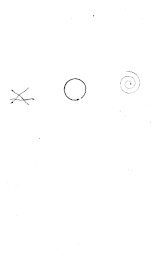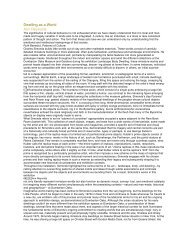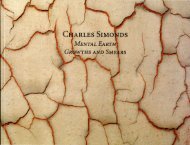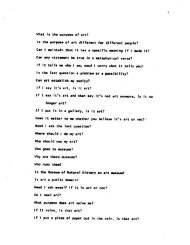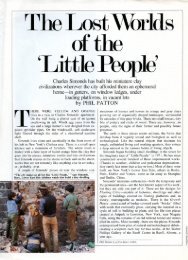Read Catalog - Charles Simonds
Read Catalog - Charles Simonds
Read Catalog - Charles Simonds
You also want an ePaper? Increase the reach of your titles
YUMPU automatically turns print PDFs into web optimized ePapers that Google loves.
Number 6 (pl. 37)<br />
All of the Circles and Towers arc imaginary moments which do<br />
not deny limitless possibilities occurring between them, before<br />
or after, or around them in all dimensions. Number 6 then<br />
is another potential extension of Number 4--the basic Circleand<br />
an oppmximatc parallel development to Nnmber 5. None<br />
of the Circles and Towers are simply equivalents to one another,<br />
hence they are displayed in an offset, staggered configuration.9<br />
The most immediate difference between Numbers 5 and 6 is<br />
that the latter has no trace of the three viewing structures. It is<br />
as though these had never existed, or they had long since been<br />
removed (such as the vestigial phallic tip which disappears from<br />
Number 4 to Number' ). 10 The high walls of the outer ring of<br />
buildings may account for this. Although both Circles are in<br />
partial ruin, the unified arc of both rings in one half of Number<br />
(,suggests the situation is under control, part of a plan. In Num<br />
/Jer 5 the basic unity of the circle is disrupted by divisions into<br />
segments so small as to read as rectangles. In Number 6, however,<br />
the gradual flow of the rubble around the circle also suggests<br />
a progressive and purposeful abandonment, as does the<br />
new construction beginning just beyond the high point of current<br />
habitation. (See "People Who Live in a Circle," p. 36.) Of<br />
particular interest again is the central dome, now entered solely<br />
by a ladder through a liplike opening on top11 and comprised<br />
of colored bricks randomly ordered and in need of new jointing.<br />
In contrast to more formal markers in Number 5, stand a stark<br />
tree trunk and jumbled logs.<br />
Number 7 (pl. 38)<br />
This moment in the imaginary evolution of <strong>Simonds</strong>'s universe<br />
refers most directly to what we know from Number 5. Now<br />
there are no apparent shelters suitable for habitation, so it is<br />
unlikely that we are viewing the landscape at a stage of penultimate<br />
demolition prior to rebuilding. The site appears abandoned,<br />
perhaps scavenged for matcrials.12 The central dome is<br />
blocked, the interior seemingly filled with refuse which precludes<br />
its collapse. Around the periphery the solid masonry of<br />
the celestial sighting structures has so far defied the clements;<br />
it is improbable that they contain anything to steal. As the last<br />
structures to be built (taking their cue from the inner dwellings),<br />
they and one small dome alone remain among the ruins with<br />
their integrity as constructions intact. Architecture-in the<br />
sense of defining interior space--has effectively ceased to exist.<br />
There are no obvious causes for the desolation, no blackened<br />
bricks, nor ash. A yellow smear broader than before suggests<br />
high water. But in <strong>Simonds</strong>'s landscape without seasons-without<br />
leaves, without clouds-we can infer no weather, no natural<br />
cataclysm nor its timing. We have only the annual rings of walls<br />
whose upward growth lies unrecorded and scattered at their<br />
base.<br />
Number 8 (pl. 39)<br />
There seems to be little here to mark the passing of a civilization-no<br />
apocalyptic broken columns, silent grassy mounds, or<br />
rusting machines. But the landscape is far from empty. A pale<br />
structural shadow of strewn bricks picks out where walls have<br />
gradually eroded into dust. The imprint is scarcely there, a<br />
slight texture toward the center. The balance has swung back<br />
to nature which reasserts its own order. This is not, however, a<br />
simple return to a beginning: the topography cannot grow itself<br />
over again; time has moved on. Nor is this the end: we know<br />
there must be stages yet to come which will obliterate utterly<br />
each geometric piece and digest it in turn again to clay. By leaving<br />
us at this moment <strong>Simonds</strong> keeps the future open. For all<br />
we know the Little People may return and transform the earth<br />
once more into their model of the universe. Or they may not.<br />
But this we are left to imagine.<br />
Number 9 (pl. 40)<br />
This landscape, containing the first of the Towers, should be<br />
compared with its direct source in Number 3 and its approximate<br />
counterpart among the Circles, Number 4· The different<br />
principles that apply to both strains are apparent, such as the<br />
focus of the Towers at one central point and their consolidation<br />
and vertical extension from the center in terms of a definite<br />
hierarchical order. We sense their common origin, but are also<br />
aware of differences in kind as well as of degree. Having followed<br />
the clues for water from Circle to Circle, we are nevertheless<br />
unaware of its presence in Number 9. There is only the<br />
glowing reddish-orange surface from which swell the familiar<br />
pale pink domes, folds, and protrusions; the most important difference<br />
is that here more phallic buds emerge than before.<br />
At the center the earth is pink and fresh, still in the process of<br />
bringing forth a sequence of telescoping folds, like new buds on<br />
a plant. From the topmost fold pushes a rounded tip so deeply<br />
cleft as to suggest further possibilities of division and metamorphosis.<br />
Four similar eruptions in various stages of development<br />
bracket the center "tower," which is further set apart by a low<br />
curving terrace wall framing six shallow domes symmetrically<br />
disposed like sepals or petals around its base. Of these domes<br />
three are topped with sharpened poles bent sideways like hooks;<br />
the three alternating domes are cleft with slight indentations.<br />
At this stage in the Towers' evolution, then, that which grows is<br />
framed and thereby organized, but is not yet overlaid with<br />
bricks, save for the cool gray terrace, shallow steps, and deeply<br />
curving pathway (set in blocks aligned to an invisible diagonal<br />
at odds with the square). Beyond the flowing wall, out around<br />
another dome, we see encircling ritual poles and other stakes<br />
placed with less apparent plan. This landscape is ordered, identified,<br />
coexisting. The vibrant color and slow curves of this<br />
floral fortress belie its imposed symmetry. We can still imagine<br />
that it grew.



